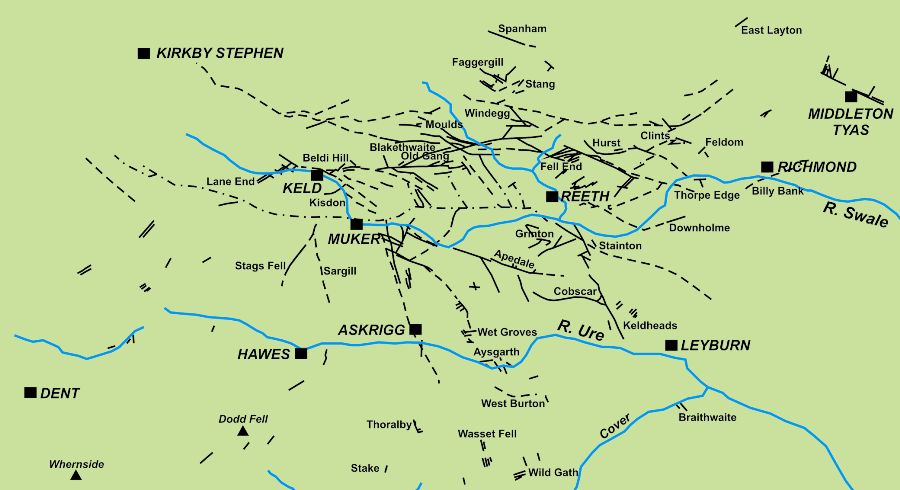Wensleydale & Swaledale
The veins on the north side of Wensleydale and in Swaledale and Arkengarthdale are richest in the Main and Underset Limestones and their associated chert beds. Because the thickest of these (the Main Limestone) rarely exceeds 21 metres in thickness the depth of mineralisation is inhibited. In some cases, however, the veins were productive over considerable distances.
This area produced most of Yorkshire’s lead and was being actively worked by monastic times. Most of this early mining was from shallow shafts where the Main Limestone outcrops, and by the late seventeenth century it was not uncommon for miners to discover that their forebears (t’old man) had already removed the ore.
During the eighteenth century, therefore, some of the heavily worked areas were reworked by hushing. This process is not fully understand, but broadly speaking the miners began quarrying the vein from the surface. Periodically the broken rock which accumulated on the floor of the hush was washed away by water released from purpose built dams. This process was repeated to produce some of the spectacular gashes which scar the hillsides, especially in Arkengarthdale.
Also during the mid eighteenth century, deeper shafts, fitted with horse whims, were sunk to get to the veins in the Main Limestone where the cover of other rocks was greater. By the end of that century, therefore, when horse levels began to be driven, the miners already had a good idea of the geological structure. This meant that levels could be driven from the correct point to give access to the bottom of the Main or Underset Limestones and provide drainage as well as a railed haulage route. Once a vein had been reached, workings were extended along it and cross-cuts were driven sideways to discover any parallel veins. These new levels meant that all the ore was brought to surface at a few points, each with its own dressing floor, making mining more efficient.
As was the case elsewhere, output from the area’s mines fluctuated according to their own ability to find ore and in response to market forces. The population peaked around 1820, but a major slump in 1830 led to many families leaving the valley, some of them to work at mines in America. The population recovered until the late 1850s, when peripheral mines began to shed labour. Thereafter, the lead industry contracted relentlessly as mines were worked out and lead prices fell. People moved away, and by 1900 the area’s population was less than half of what it had been in 1820. This time many families moved to the developing coalfields, especially north-east Lancashire, where the cotton mills gave work for women and older children.
The last mines to close were the Old Gang in Swaledale in 1906, and Faggergill in Arkengarthdale in 1912. A small group of men recovered barytes from mine dumps until around 1990.
Please also see the Smelting Mills of the Yorkshire Dales
Sources for further information:
- Swaledale Museum, The Green, Reeth, Richmond, North Yorkshire, DL11 6TX
- Dales Countryside Museum, Station Yard, Hawes, North Yorkshire, DL8 3NT
Please note NMRS does not have any control over the contents of external websites
Return to previous page

